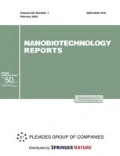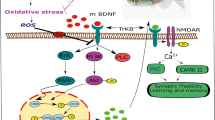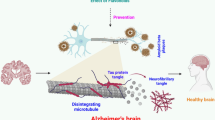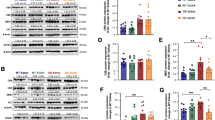Abstract
An urgent task of modern medicine is the search for drugs that can stop or slow down the course of neurodegenerative diseases, in particular Alzheimer’s disease. The aim of this work was to determine the effect of fullerenol C60(OH)30 on the pathogenesis of Alzheimer’s disease in the Drosophila melanogaster model. The effect of fullerenol on the life expectancy, the level of geotaxis, learning and memory, and the levels of neurodegeneration and reactive oxygen species in the animal brain was studied. Based on the results, it can be assumed that fullerenol C60(OH)30 is a promising agent for the development of complex therapy for Alzheimer’s disease.






Similar content being viewed by others
REFERENCES
S. Tiwari, V. Atluri, A. Kaushik, et al., Int. J. Nanomed. 14, 5541 (2019).
C. A. Lane, J. Hardy, and J. M. Schott, Eur. J. Neurol. 25, 59 (2018).
P. Marešová, H. Mohelská, J. Dolejš, and K. Kuča, Curr. Alzheimer Res. 12, 903 (2015).
D. J. Selkoe, Behav. Brain Res. 192, 106 (2008).
X. Q. Chen and W. C. Mobley, Front. Neurosci. 13, 659 (2019).
E. Koseoglu, World J. Clin. Cases 7, 1764 (2019).
A. G. Bobylev, L. G. Marsagishvili, M. D. Shpagina, V. S. Romanova, R. A. Kotelnikova, and Z. A. Podlubnaya, Biophysics 55, 353 (2010).
A. G. Bobylev, Yu. V. Shatalin, I. M. Vikhlyantsev, L. G. Bobyleva, S. V. Gudkov, and Z. A. Podlubnaya, Biophysics 59, 685 (2014).
Z. Bednarikova, P. D. Q. Huy, M. M. Mocanu, et al., Phys. Chem. Chem. Phys. 18, 18855 (2016).
U. B. Pandey and C. D. Nichols, Pharmacol. Rev. 63, 411 (2011).
L. McGurk, A. Berson, and N. M. Bonini, Genetics 201, 377 (2015).
L. Tsuda and Y. M. Lim, Adv. Exp. Med. Biol. 1076, 25 (2018).
A. Borisenkova, M. Suyasova, et al., Mater. Sci. Eng. C 104, 109945 (2019).
M. Hirohata, K. Ono, J. Takasaki, et al., Biochim. Biophys. Acta 1822, 1316 (2012).
K. Iijima, H. P. Liu, A. S. Chiang, et al., Proc. Natl. Acad. Sci. U. S. A. 101, 6623 (2004).
A. H. Brand and N. Perrimon, Development 118, 401 (1993).
T. Tully and W. G. Quinn, J. Comp. Physiol. 157, 263 (1985).
J. E. Kim and M. Lee, Biochem. Biophys. Res. Commun. 303, 576 (2003).
Z. Chen and C. Zhong, Neurosci Bull. 30, 271 (2014).
E. Tonnies and E. Trushina, J. Alzheimers Dis. 57, 1105 (2017).
L. Cassidy, F. Fernez, J. B. Johnson, et al., Theor Med. 49, 102294 (2020).
Z. A. Podlubnaya, I. Ya. Podol’skii, M. D. Shpagina, and L. G. Marsagishvili, Biophysics 51, 701 (2006).
I. M. Marusenko, Ya. A. Avdeeva, and I. I. Pol’skaya, Sovrem. Revmatol., No. 3, 50 (2009).
R. Gordon, I. Podolski, E. Makarova, et al., J. Alzheimers Dis. 58, 711 (2017).
ACKNOWLEDGMENTS
The authors are grateful to A. Borisenkova for the samples of fullerenol provided.
Funding
This study was supported by the Russian Foundation for Basic Research, project no. 15-29-00153a.
Author information
Authors and Affiliations
Corresponding author
Rights and permissions
About this article
Cite this article
Slobodina, A.D., Bolshakova, O.I., Komissarov, A.E. et al. Study of the Neuroprotective Properties of Fullerenol C60(OH)30 with a Model of Alzheimer’s Disease. Nanotechnol Russia 15, 212–217 (2020). https://doi.org/10.1134/S1995078020020184
Received:
Revised:
Accepted:
Published:
Issue Date:
DOI: https://doi.org/10.1134/S1995078020020184




